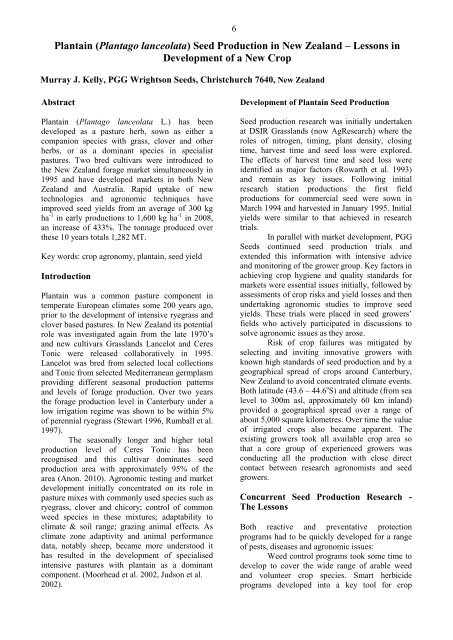IHSG newsletter 46 .pdf - International Herbage Seed Group
IHSG newsletter 46 .pdf - International Herbage Seed Group
IHSG newsletter 46 .pdf - International Herbage Seed Group
Create successful ePaper yourself
Turn your PDF publications into a flip-book with our unique Google optimized e-Paper software.
Plantain (Plantago lanceolata) <strong>Seed</strong> Production in New Zealand – Lessons in<br />
Development of a New Crop<br />
Murray J. Kelly, PGG Wrightson <strong>Seed</strong>s, Christchurch 7640, New Zealand<br />
6<br />
Abstract<br />
Plantain (Plantago lanceolata L.) has been<br />
developed as a pasture herb, sown as either a<br />
companion species with grass, clover and other<br />
herbs, or as a dominant species in specialist<br />
pastures. Two bred cultivars were introduced to<br />
the New Zealand forage market simultaneously in<br />
1995 and have developed markets in both New<br />
Zealand and Australia. Rapid uptake of new<br />
technologies and agronomic techniques have<br />
improved seed yields from an average of 300 kg<br />
ha -1 in early productions to 1,600 kg ha -1 in 2008,<br />
an increase of 433%. The tonnage produced over<br />
these 10 years totals 1,282 MT.<br />
Key words: crop agronomy, plantain, seed yield<br />
Introduction<br />
Plantain was a common pasture component in<br />
temperate European climates some 200 years ago,<br />
prior to the development of intensive ryegrass and<br />
clover based pastures. In New Zealand its potential<br />
role was investigated again from the late 1970‟s<br />
and new cultivars Grasslands Lancelot and Ceres<br />
Tonic were released collaboratively in 1995.<br />
Lancelot was bred from selected local collections<br />
and Tonic from selected Mediterranean germplasm<br />
providing different seasonal production patterns<br />
and levels of forage production. Over two years<br />
the forage production level in Canterbury under a<br />
low irrigation regime was shown to be within 5%<br />
of perennial ryegrass (Stewart 1996, Rumball et al.<br />
1997).<br />
The seasonally longer and higher total<br />
production level of Ceres Tonic has been<br />
recognised and this cultivar dominates seed<br />
production area with approximately 95% of the<br />
area (Anon. 2010). Agronomic testing and market<br />
development initially concentrated on its role in<br />
pasture mixes with commonly used species such as<br />
ryegrass, clover and chicory; control of common<br />
weed species in these mixtures; adaptability to<br />
climate & soil range; grazing animal effects. As<br />
climate zone adaptivity and animal performance<br />
data, notably sheep, became more understood it<br />
has resulted in the development of specialised<br />
intensive pastures with plantain as a dominant<br />
component. (Moorhead et al. 2002, Judson et al.<br />
2002).<br />
Development of Plantain <strong>Seed</strong> Production<br />
<strong>Seed</strong> production research was initially undertaken<br />
at DSIR Grasslands (now AgResearch) where the<br />
roles of nitrogen, timing, plant density, closing<br />
time, harvest time and seed loss were explored.<br />
The effects of harvest time and seed loss were<br />
identified as major factors (Rowarth et al. 1993)<br />
and remain as key issues. Following initial<br />
research station productions the first field<br />
productions for commercial seed were sown in<br />
March 1994 and harvested in January 1995. Initial<br />
yields were similar to that achieved in research<br />
trials.<br />
In parallel with market development, PGG<br />
<strong>Seed</strong>s continued seed production trials and<br />
extended this information with intensive advice<br />
and monitoring of the grower group. Key factors in<br />
achieving crop hygiene and quality standards for<br />
markets were essential issues initially, followed by<br />
assessments of crop risks and yield losses and then<br />
undertaking agronomic studies to improve seed<br />
yields. These trials were placed in seed growers‟<br />
fields who actively participated in discussions to<br />
solve agronomic issues as they arose.<br />
Risk of crop failures was mitigated by<br />
selecting and inviting innovative growers with<br />
known high standards of seed production and by a<br />
geographical spread of crops around Canterbury,<br />
New Zealand to avoid concentrated climate events.<br />
Both latitude (43.6 – 44.6 o S) and altitude (from sea<br />
level to 300m asl, approximately 60 km inland)<br />
provided a geographical spread over a range of<br />
about 5,000 square kilometres. Over time the value<br />
of irrigated crops also became apparent. The<br />
existing growers took all available crop area so<br />
that a core group of experienced growers was<br />
conducting all the production with close direct<br />
contact between research agronomists and seed<br />
growers.<br />
Concurrent <strong>Seed</strong> Production Research -<br />
The Lessons<br />
Both reactive and preventative protection<br />
programs had to be quickly developed for a range<br />
of pests, diseases and agronomic issues:<br />
Weed control programs took some time to<br />
develop to cover the wide range of arable weed<br />
and volunteer crop species. Smart herbicide<br />
programs developed into a key tool for crop












